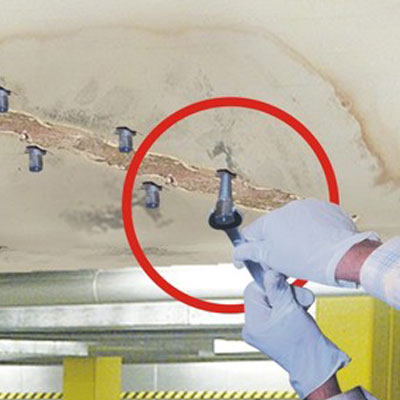 21 Nov 2020
21 Nov 2020
Water dripping on your head through your leaky ceiling is not a pleasant sight. Water leaks are silent enemies of home improvement and remain unidentifiable most of the time. You would not know the extent of the damage until you find the leakage source. It also leads to some other problems like discoloration, buckling plaster, and peeling paint. So, you need to troubleshoot and take active steps for ceiling leak repair.
If at any point, you become helpless in identifying the plumbing leak in the wall, then do not worry. You always have an option available to call a professional plumbing contractor to help you out with leaks.
How To Identify The Ceiling Leak?
Water dripping down the wall is evidence that you have leakage in the house. It may indicate to some holes in the pipes, any damages to the shingles, or other exterior roof material. The water leaves a trail behind and causes puddles on the floor.
Once you are sure of the leakage, identifying its source is the next step. You can look through your ceiling system and plumbing system to pick out the cause.
Check The Roofing System
One telltale sign of a ceiling leak is the dirty water. Its source could be anywhere in the roofing system. You can check out the materials used in the ceiling. The worn out and damaged roofing material causes ceiling leaks.
Further, check the blockage in gutters, inspect the flashing on exterior vents, windows, or chimneys, and look for compromised caulking or shingles. Any of these can cause leakage in your ceiling.
Look Through The Drainage System
If the water is leaking from a lower-level, the problem could be underneath the external site. Many damages can cause this kind of leakage, including broken or leaking sprinkle pipes, drains, sloped grading to the house, and improper drainage from downspouts. All these sources will help you find the leakage.
Find Plumbing Leak In The Wall
When you find the ceiling leakage or dripping water below the ceiling spaces in the bathroom and kitchen, where plumbing pipes or fixtures are present, it indicates a plumbing issue. It can suggest that the problem is due to a developed leakage in water supply pipes and drains.
Moreover, another way to identify plumbing leaks in the wall is clean and clear water. Water trickling directly from the pipes will be clean and fresh.
Plumbing leaks can turn out to be problematic. You do not have to open the ceiling or walls to identify the cause. To determine the leaking in the bathroom, kitchen, or plumber fixture, you can use the process of elimination.
Further, domestic leakage will be consistent and continuous. In contrast, a waste line leakage will occur only when you run the fixture. So, it is better to inspect the ceiling leaks with your eyes first as the seeping water is evident.
Once you have identified the reason for roof leaks, then you troubleshoot the problem. You can gather information on its fixing, collect the tools, and make plans to repair wall and ceiling leakage.
What To Do For Ceiling Leak Repair?
After the inspection of the leaking ceiling and walls, you move towards ceiling leak repair. First, you should take measures to avoid any further damage or trickling water. The water can outspread under the ceiling surfaces, so you need to drain it out first. So, the standing water will not damage or disintegrate the ceiling further.
Next, you will look for specific solutions for your ceiling leakage.
For Roofing And Drainage Leaks
The damages in the ceiling can be small or complex. You might need a ceiling leak repair or the entire replacement of the ceiling surface. But, you can prevent the roofing and drainage leaks by regular maintenance and cleaning.
Roofing System issues need the following repairs:
Gutters And Downspout Clogging: You should clean the gutters and downspouts regularly to avoid any collection of debris. Make sure that the water flowing in the channels is consistent and does not block anywhere.
Sprinkler System: Mostly, if you replace the pipes of your sprinkler system, the problem resolves.
Flashing: Water leakage can occur through flashing. The flashing used in the chimneys and vents needs proper inspection and restoration.
Caulking: Firstly, you have to scrap out previous caulking. Then, get the correct type of caulking, load up the caulk gun, and apply it on the roof.
Repairing these roof damages can be easy or challenging. If you can fix any of these by yourself, then that’s great. However, for extreme damages, you would need to consult a professional plumber.
Fixing Plumbing Leak In The Wall
If you identify a plumbing leak in the wall, it is better to call in a trained plumber. A professional would know where to cut the plumbing system and replace the damaged section.Also, the patching, painting, and fixing of the wall is a forte of a plumbing contractor in Singapore.
Call A Professional Plumber In Singapore
With small damages or a single hole, you can take the chance to repair it yourself. But, when it comes to ceiling leak repair and plumbing fixtures, they are not easy to do. In such circumstances, it is recommended to contact a roofing specialist or trained plumber to handle the damage.
A plumbing contractor in Singapore can patch your roof leakage effectively. They have all the equipment and tools ready to reach the high roof for repairing and replacement. Also, they do systematic and organized ceiling repair at affordable prices.
K. Heng Plumbing in Singapore understands the problems you can face due to water leakage. They are ever ready to tackle this urgent situation, whether it is a slight nuisance or significant roof damage. The ceiling leak repair professionals of K. Heng Plumbing identify, troubleshoot, and repair your roof in a time-efficient and adequate manner.
For more information about the ceiling repair and leaks, contact K. Heng Plumbing now!
